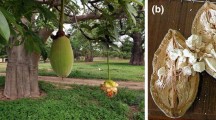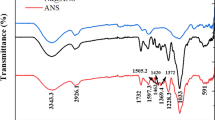Abstract
A recyclable activated carbon adsorbent with a highly negative surface charge was synthesized from bael fruit shell waste. The structural, morphological, and surface properties of the activated carbon adsorbent were evaluated using XRD, FE-SEM, FTIR, zeta potential, and BET surface area analysis. The results demonstrated that the surface area of the activated carbon adsorbent got significantly enhanced (944.09 m2/g) as compared to that of the carbonized material (2.43 m2/g) which was validated through FE-SEM analysis. The zeta potential value of activated carbon (− 16.2 mV) reveals that the net surface charge of the activated carbon is negative, which leads to 94.15% removal of methylene blue dye (cationic) as compared to 65.71% and 50.59% removal of rhodamine B (zwitterionic) and reactive red (anionic) dyes, respectively. This could be due to the electrostatic attraction between the cationic methylene blue dye and the negative surface of activated carbon. Furthermore, the adsorption data revealed that 300 mg of activated carbon, 50 ppm initial concentration, and pH of 6.56 are the optimum conditions for enhanced adsorption capacity of activated carbon towards methylene blue pollutant. The adsorption experimental data were best fitted into the Langmuir isotherm and second-order kinetic model (R2 = 0.99–1.00). In addition, the activated carbon was successfully regenerated and reused up to 5 cycles of adsorption experiments where the adsorption efficiency was retained. Therefore, the bael fruit shell waste–derived activated carbon adsorbent with a high negative surface charge could be a potential alternative to commercial counterparts in the selective removal of pollutants removed from the wastewater stream.














Similar content being viewed by others
References
Adegoke KA, Bello OS (2015) Dye sequestration using agricultural wastes as adsorbents. Water Resour Ind 12:8–24. https://doi.org/10.1016/j.wri.2015.09.002
Bordoloi N, Dey MD, Mukhopadhyay R, Kataki R (2018) Adsorption of methylene blue and rhodamine B by using biochar derived from Pongamia glabra seed cover. Water Sci Technol 77(3):638–646. https://doi.org/10.2166/wst.2017.579
Dutta S, Gupta B, srivastava, S.K., & Gupta, A. K. (2021) Recent advances on the removal of dyes from wastewater using various adsorbents: a critical review. Mater Adv 2:4497–4531. https://doi.org/10.1039/d1ma00354b
Yagub MT, Sen TK, Afroze S, Ang HM (2014) Dye and its removal from aqueous solution by adsorption: a review. Adv Colloid Interface Sci 209:172–184
Hameed BH, Ahmad AA (2009) Batch adsorption of methylene blue from aqueous solution by garlic peel, an agricultural waste biomass. J Hazard Mater 164(2–3):870–875. https://doi.org/10.1016/j.jhazmat.2008.08.084
Lellis B, Fávaro-Polonio CZ, Pamphile JA, Polonio JC (2019) Effects of textile dyes on health and the environment and bioremediation potential of living organisms. Biotechnol Res Innov 3(2):275–290. https://doi.org/10.1016/j.biori.2019.09.001
Aragaw TA, Bogale FM (2021) Biomass-based adsorbents for removal of dyes from wastewater: a review. Front. Environ. Sci. 9:764958. https://doi.org/10.3389/fenvs.2021.764958
Allen SJ, Koumanova B (2005) Decolourisation of water/wastewater using adsorption. J Univ Chem Technol Metall 40:175–192
El-Bery HM, Saleh M, El-Gendy RA, Saleh MR, Thabet SM (2022) High adsorption capacity of phenol and methylene blue using activated carbon derived from lignocellulosic agriculture wastes. Sci Rep 12:5499. https://doi.org/10.1038/s41598-022-09475-4
Mousavi SA, Mahmoudi A, Amiri S, Darvishi P, Noori E (2022) Methylene blue removal using grape leaves waste: optimization and modeling. Appl Water Sci 12:112. https://doi.org/10.1007/s13201-022-01648-w
Koilraj P, Kannan S (2010) Phosphate uptake behavior of ZnAlZr ternary layered double hydroxides through surface precipitation. J Colloid Interface Sci 341:289–297. https://doi.org/10.1016/j.jcis.2009.09.059
Rafatullah M, Sulaiman O, Hashim R, Ahmad A (2010) Adsorption of methylene blue on low-cost adsorbents: a review. J Hazard Mater 177:70–80. https://doi.org/10.1016/j.jhazmat.2009.12.047
Efome JE, Rana D, Matsuura T, Lan CQ (2018) Experiment and modeling for flux and permeate concentration of heavy metal ion in adsorptive membrane filtration using a metal-organic framework incorporated nanofibrous membrane. Chem Eng J 352:737–744. https://doi.org/10.1016/j.cej.2018.07.077
Efome JE, Rana D, Matsuura T, Lan CQ (2018) Metal–organic frameworks supported on nanofibers to remove heavy metals. J Mater Chem 6(10):4550–4555. https://doi.org/10.1039/C7TA10428F
Efome JE, Rana D, Matsuura T, Lan CQ (2018) Insight studies on metal-organic framework nanofibrous membrane adsorption and activation for heavy metal ions removal from aqueous solution. ACS Appl Mater Interfaces 10(22):18619–18629. https://doi.org/10.1021/acsami.8b01454
Efome JE, Rana D, Matsuura T, Lan CQ (2019) Effects of operating parameters and coexisting ions on the efficiency of heavy metal ions removal by nano-fibrous metal-organic framework membrane filtration process. Sci Total Environ 674:355–362. https://doi.org/10.1016/j.scitotenv.2019.04.187
Park SJ, Kim KD (1999) Adsorption behaviors of CO2 and NH3 on chemically surface-treated activated carbons. J Colloid Interface Sci 212:186–189. https://doi.org/10.1006/jcis.1998.6058
Deng H, Lu J, Li G, Zhang G, Wang X (2011) Adsorption of methylene blue on adsorbent materials produced from cotton stalk. Chem Eng J 172:326–334. https://doi.org/10.1016/j.cej.2011.06.013
El-Nemr MA, Abdelmonem NM, Ismail IMA, Ragab S, El-Nemr A (2020) Removal of Acid Yellow 11 dye using a novel modified biochar derived from watermelon peels. Dwt 203:403–431. https://doi.org/10.5004/dwt.2020.26207
Januário EFD, Vidovix TB, Araújo LAd, Bergamasco Beltran L, Bergamasco R, Vieira AMS (2021) Investigation of Citrus reticulata peels as an efficient and low-cost adsorbent for the removal of safranin orange dye. Environ Tech 1:1–15. https://doi.org/10.1080/09593330.2021.1946601
Shakir K, Elkafrawy AF, Ghoneimy HF, Beheir SGE, Refaat M (2010) Removal of rhodamine B (a basic dye) and thoron (an acidic dye) from dilute aqueous solutions and wastewater simulants by ion flotation. Water Res 44(5):1449–1461
Thang NH, Khang DS, Hai TD, Nga DT, Tuan PD (2021) Methylene blue adsorption mechanism of activated carbon synthesised from cashew nut shells. RSC Adv 11:26563–26570. https://doi.org/10.1039/d1ra04672a
Al-Gheethi AA, Azhar QM, Senthilkumar P, Yusuf AA, Al-Buriahi AK, Mohamed RMSR, Al-shaibani MM (2022) Sustainable approaches for removing rhodamine B dye using agricultural waste adsorbents: a review. Chemosphere 287:132080. https://doi.org/10.1016/j.chemosphere.2021.132080
Malhotra M, Suresh S, Garg A (2018) Tea waste derived activated carbon for the adsorption of sodium diclofenac from wastewater: adsorbent characteristics, adsorption isotherms, kinetics, and thermodynamics. Environ Sci Pollut Res 25:32210–32220. https://doi.org/10.1007/s11356-018-3148-y
Hou J, Liu Y, Wen S, Li W, Liao R, Wang L (2020) Sorghum-waste-derived high-surface area KOH-activated porous carbon for highly efficient methylene blue and Pb(II) removal. ACS Omega 5(23):13548–13556. https://doi.org/10.1021/acsomega.9b04452
Baliga MS, Mane PP, Joseph N, Jimmy R (2013) Review on the protective effects of the indigenous Indian medicinal plant, bael (Aegle marmelos Correa), in gastrointestinal disorders. Bioact Food Diet Intervent Liver Gastrointest Dis :313–324. https://doi.org/10.1016/b978-0-12-397154-8.00036-1
Ramakrishna YG, Savithri K, Kist M, Devaraj SN (2015) Aegle marmelos fruit extract attenuates Helicobacter pylori Llpopolysaccharide induced oxidative stress in Sprague Dawley rats. BMC Complement Alternat Med 15(1).https://doi.org/10.1186/s12906-015-0915-x
Roy K, Verma KM, Vikrant K, Goswami M, Sonwani RK, Rai BN, Vellingiri K, Kim KH, Giri BS, Singh RS (2018) Removal of patent blue (V) dye using Indian bael shell biochar: characterization application and kinetic studies. Sustain 10(8). https://doi.org/10.3390/su10082669
Belhachemi M (2021) Chapter 14 - Adsorption of organic compounds on activated carbons, Editor(s): Avelino Núñez-Delgado, Sorbents materials for controlling environmental pollution, Elsevier, p 355–385. https://doi.org/10.1016/B978-0-12-820042-1.00006-7
Bhattacharyya KG, SenGupta S, Sarma GK (2014) Interactions of the dye, rhodamine B with kaolinite and montmorillonite in water. Appl Clay Sci 99:7–17. https://doi.org/10.1016/j.clay.2014.07.012
Kishibayev KK, Serafin J, Tokpayev RR, Khavaza TN, Atchabarova AA, Abduakhytova DA, Ibraimov ZT, Sreńscek-Nazzal J (2021) J Environ Chem Eng 9:106798. https://doi.org/10.1016/j.jece.2021.106798
Khosrowshahi MS, Mashhadimoslem H, Emrooz HBM, Ghaemi A, Hosseini MS (2022) Green self-activating synthesis system for porous carbons: celery biomass wastes as a typical case for CO2 uptake with kinetic, equilibrium and thermodynamic studies. 109204. https://doi.org/10.1016/j.diamond.2022.109204
Demir M, Kahveci Z, Aksoy B, Palapati NKR, Subramanian A, Cullinan HT, El-Kaderi HM, Harris CT, Gupta RB (2015) Graphitic biocarbon from metal-catalyzed hydrothermal carbonization of lignin. Ind Eng Chem Res 54(43):10731–10739. https://doi.org/10.1021/acs.iecr.5b02614
Nizam NUM, Hanafiah MM, Mahmoudi E, Halim AA, Mohammad AW (2021) The removal of anionic and cationic dyes from an aqueous solution using biomass-based activated carbon. Sci Rep 11:8623. https://doi.org/10.1038/s41598-021-88084-z
Lendzion-Bieluń Z, Czekajło Ł, Sibera D, Moszyński D, Sreńscek-Nazzal J, Morawski AW, Wrobel RJ, Michalkiewicz B, Arabczyk W, Narkiewicz U (2017) Surface characteristics of KOH-treated commercial carbons applied for CO2 adsorption. Adsorpt Sci Technol 36(1–2):478–492. https://doi.org/10.1177/0263617417704527
Özsin G, Kılıç M, Apaydın-Varol E, Pütün AE (2019) Chemically activated carbon production from agricultural waste of chickpea and its application for heavy metal adsorption: equilibrium, kinetic, and thermodynamic studies. Appl Water Sci 9:56. https://doi.org/10.1007/s13201-019-0942-8
Ravichandran P, Sugumaran P, Seshadri S, Basta AH (2018) Optimizing the route for production of activated carbon from Casuarina equisetifolia fruit waste. Royal Society Open Science 5(7):171578. https://doi.org/10.1098/rsos.171578
Thongpat W, Taweekun J, Maliwan K (2021) Synthesis and characterization of microporous activated carbon from rubberwood by chemical activation with KOH. Carbon Lett 31:1079–1088. https://doi.org/10.1007/s42823-020-00224-z
Zhang L, Zhang H, Tian Y, Chen Z, Han Lu (2012) Adsorption of methylene blue from aqueous solutions onto sintering process red mud. Desalin Water Treat 47(1–3):31–41. https://doi.org/10.1080/19443994.2012.696412
Lim S, Kim JH, Park H, Kwak C, Yang J, Kim J, Ryu SY, Lee J (2021) Role of electrostatic interactions in the adsorption of dye molecules by Ti3C2-MXenes. RSC Adv 11:6201–6211. https://doi.org/10.1039/D0RA10876F
Dawood S, Sen TK, Phan C (2016) Adsorption removal of methylene blue (MB) dye from aqueous solution by bio-char prepared from Eucalyptus sheathiana bark: kinetic, equilibrium, mechanism, thermodynamic and process design. Desalin Water Treat 57(59):28964–28980. https://doi.org/10.1080/19443994.2016.1188732
Al-Ghouti MA, Al-Absi RS (2020) Mechanistic understanding of the adsorption and thermodynamic aspects of cationic methylene blue dye onto cellulosic olive stones biomass from wastewater. Sci Rep 10:15928. https://doi.org/10.1038/s41598-020-72996-3
Natarajan TS, Bajaj HC, Tayade RJ (2014) Preferential adsorption behavior of methylene blue dye onto surface hydroxyl group enriched TiO2 nanotube and its photocatalytic regeneration. J Colloid Interface Sci 433:104–114. https://doi.org/10.1016/j.jcis.2014.07.019
Kalam S, Abu-Khamsin SA, Kamal MS, Patil S (2021) Surfactant adsorption isotherms: a review. ACS Omega 6(48):32342–32348. https://doi.org/10.1021/acsomega.1c04661
Ragupathy S, Raghu K, Prabu P (2015) Synthesis and characterization of TiO2 loaded cashew nut shell activated carbon and photocatalytic activity on BG and MB dyes under sunlight radiation, Spectrochim. Acta Part A Mol Biomol Spectrosc 138:314–320
Liu Y, Zhao X, Li J, Ma D, Han R (2012) Characterization of bio-char from pyrolysis of wheat straw and its evaluation on methylene blue adsorption. Desalin Water Treat 46:115–123
Aboua KN, Yobouet YA, Yao KB, Gone ́DL, Trokourey A (2015) Investigation of dye adsorption onto activated carbon from the shells of Macoré fruit. J Environ Manag 156:10–14
Acknowledgements
The authors thank the director of CSIR-CLRI for the continuous support.
Funding
CSIR-CLRI Communication No.: 1695. The authors acknowledge the institute for financial support through MLP projects (MLP-19 and MLP-27).
Author information
Authors and Affiliations
Contributions
VM: Conceptualization, methodology, data curation, writing—original draft preparation, review and editing.
TSN: Conceptualization, methodology, data curation, writing—original draft preparation, review and editing.
Corresponding authors
Ethics declarations
Conflict of interest
The authors declare no competing interests.
Additional information
Publisher's note
Springer Nature remains neutral with regard to jurisdictional claims in published maps and institutional affiliations.
Rights and permissions
Springer Nature or its licensor holds exclusive rights to this article under a publishing agreement with the author(s) or other rightsholder(s); author self-archiving of the accepted manuscript version of this article is solely governed by the terms of such publishing agreement and applicable law.
About this article
Cite this article
Mozhiarasi, V., Natarajan, T.S. Bael fruit shell–derived activated carbon adsorbent: effect of surface charge of activated carbon and type of pollutants for improved adsorption capacity. Biomass Conv. Bioref. 14, 8761–8774 (2024). https://doi.org/10.1007/s13399-022-03211-8
Received:
Revised:
Accepted:
Published:
Issue Date:
DOI: https://doi.org/10.1007/s13399-022-03211-8




